- What is the
significance of Kurukshetra? Historicity of the presence of Harsha Tila and Ruins of a Stupa. What to expect
at Brahma Sarovar, Jyotisar, Sthaneshwar Mahadeva Temple, Krishna and Dharohar Museums?
Nestled in the
heart of the north Indian state of Haryana lies Kurukshetra, a land steeped in
history, mythology, and spirituality. As I embarked on my journey to this
ancient city, I was filled with anticipation and curiosity, eager to delve into
its rich tapestry of culture and heritage.
The name Kurukshetra instantly invokes images of the epic battle of the Mahabharata, a conflict that took place on these very plains thousands of years ago. As I stood amidst the vast expanse of Kurukshetra, I couldn't help but feel the weight of history bearing down on me. The significance of this land as the setting for one of the greatest tales ever told was palpable, and I found myself transported back in time to an era of kings, warriors, and divine intervention.
Well this is the
opening that a typical ChatGPT query will generate. And no, there is nothing
necessarily wrong about it. The problem here, though, is one of insufficiency
of information. Imagination of the scale and the significance of Kurukshetra is
actually stymied by the current geographical boundaries and the lack of
awareness, even among the locals sadly, on just how precious the land is today.
For me though, a brief visit one weekend was enough to realise that Kurukshetra is the Kashi that we haven’t been told about enough.
Significance of Kurukshetra – Way More than One Realises
Today,
Kurukshetra has been reduced to the idea of the Mahabharata war. But what was
Kurukshetra?
When one looks at the realms of what Kurukshetra, you realise the fact that scholars like the late scholar-philosopher Dr. H S Sinha always emphasised – that the great Mahabharata war took place at this place because of its already great significance. It was never the case that the Mahabharata war imparted significance to this great tirtha.
Lying on the
banks of the mighty Saraswati River, one still sees its imprints everywhere,
from culture to agriculture, as its remnant memories continue to influence
Dharma and its practices. For instance, as my lovely guides Vikas Sharma and
Raghavender Bawa reminded me, the Puranas instruct that there is no need to
pick the ashes for Ganga visarjana of those who die within the 48 kms
Kurukshetra region.
Kurukshetra in the Puranas refers to a 48 kos (1 kos=3.5kms) stretch on the banks of the Saraswati, which was guarded by four yakshas at each of its corners. This association with Yaksha is equally fascinating, given how these mythical figures were associated with the protection of water bodies, and post vinashana, we see the Brahma Sarovar – Jyotisar duo being the key water figure that was considered a sea on land by the laymen.
This 48 kos area’s expanse was bounded by Kurukshetra, Karnal and Panipat in the east and Kaithal and Jind in the west, covering pretty much the entire district as it stands today. It must be pointed out that the district of Kuruskhetra came into existence only in 1973 by carving it out of Karnal district.
 Pictorial Representation of the Expanse of 48kos Kurukshetra
Pictorial Representation of the Expanse of 48kos Kurukshetra
Picture source here
Each square inch
of this land is sacred to Hindus, with over 360
pilgrim sites. Of these, sadly, only 134 remain in existence today, with
the remaining being wiped out due to invasions and colonialism. 1 As the travel guide on Kurukshetra hosted on the government site reminds you, in fact, Kurukshetra’s importance was so high that a 5th century Laos prashasti talked about establishing a new Kurukshetra there!
This 5th
century Champassak Inscription by King Devanika of Sanskrit Hindu Khmer kingdom,
while comparing him with Puranic heroes, praised him for establishing this
talked about establishing this new Kurukshetra.
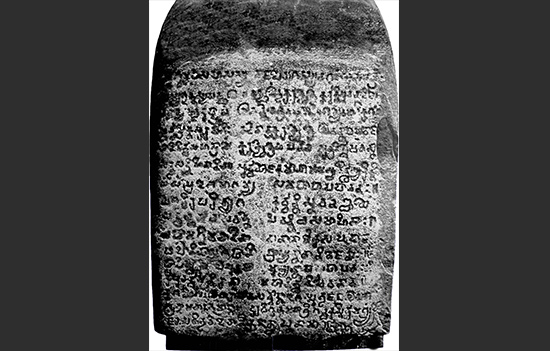 Devanika’s Inscription
Devanika’s Inscription
Pic source link
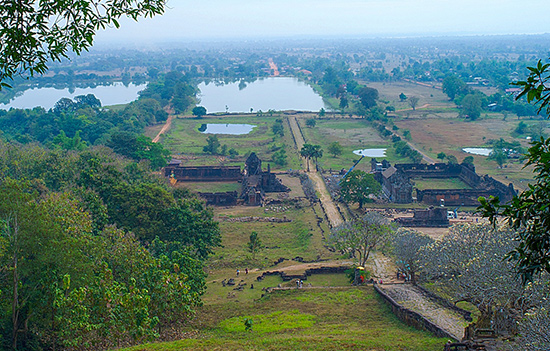 Landscape
of Vat Phou Kuruksheta in Laos (UNESCO).
Landscape
of Vat Phou Kuruksheta in Laos (UNESCO).
Pic source link
Historicity of Thanesar-the Presence of Harsha
Tila and the Ruins of a Stupa
Few people remember today that Harshavardhana used to rule
from Thanesar, the very city that has been identified with Kurukshetra. Harsh ka Tila is believed to be the site where probably the king used to rule from; today Sheikh Chili’s tomb stands at that spot.
However, historically we do see the reference to Thanesar in the writings of
Hiuen Tsang, the Chinese traveller. A brief of the descriptions follows:
There were (that is, at the capital
apparently) three Buddhist monasteries with above 700 professed Buddhists, all
Hinayanists. There were also above 100 Deva- Temples and the non-Buddhists were
very numerous.
One of these monasteries was once within the premise of
Kurukshetra University. Today, it is maintained as a separate entity, with a
boundary wall being built to give it protection. Some Neo-Buddhists are now
securing and developing the site with foreign aid.
However, it is rather fascinating that this continuity persists for ages. Gurdwara Chhevin Patshahi was located right next to this Buddhist era site, which also brings into focus the Dharmic continuity of the region’s history. Incidentally, Kurukshetra is the
only tirtha in India which was visited by nine of the Sikh Gurus, with
gurdwaras marking the historicity of their visits all over.
 Buddhist remains at Kurukshetra, now
surrounded by a garden. Pic by author.
Buddhist remains at Kurukshetra, now
surrounded by a garden. Pic by author.
This city and the region around it has seen several
extensive excavations being carried out. Of course, few remember that Saraswati
Sindhu civilization sites are also found in Kurukshetra district adjacent to
the Raja Karan ka Tila.2 Given how
Rakhigarhi, the largest and oldest site, is 123 km away, and very much forms
the 48 kos (1kos=3.5 kms) Kurukshetra belt with its location at the
south-western edge of the region.
This sense of
historicity of the city starts to increase even more, as one visits the Krishna Museum.
The multimedia presentation apart, it was fascinating to see artefacts from not just the Saraswati Sindhu civilizational era, but even later phases – Kushan, Gupta, the Vardhan/later Gupta Empire and much more. The sheer number of figures that one saw of Uma Maheshwara, Surya, Durga and many more makes one realise that Kurukshetra’s itihaasa is clearly one that might rival Kashi’s if one were to start tracing it through a serious academic
effort.
For instance,
one of the finest panel fragments of the navagrahas (nine planets) was discovered from Harsha ka Tila, where now also sits Sheikh Chili’s tomb. These discussions and discoveries made me wonder why we have forgotten the significance of Kurukshetra, which perhaps was no less than Kashi.
Did the cruel
power of repeated invasions make us give up on the significance of the tirtha
kshetra for us? Was it a collective fade of collective memory that made us give
up on it?
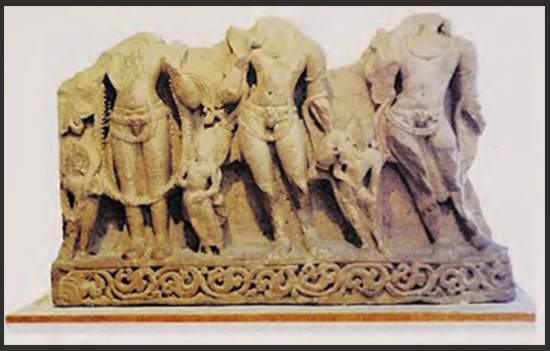 Fragment of the Navagraha panel
found from Harsha ka Tila (source: Pande and Dorje, 2016) 3
Fragment of the Navagraha panel
found from Harsha ka Tila (source: Pande and Dorje, 2016) 3
Brahma Sarovar and Jyotisar – The Sea on Land
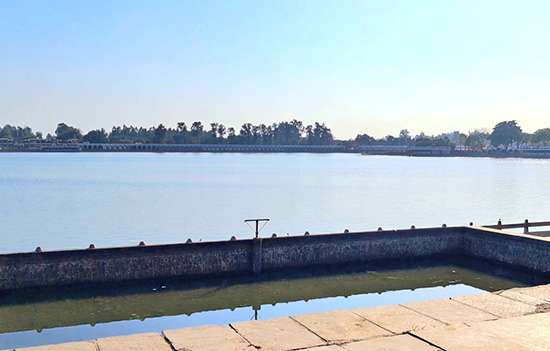
As I walked
around the Brahma Sarovar, a sense of calm descended on me. The sarovar was
renovated by its old Member of Parliament Shri Gulzarilal Nanda. As a result the ghats had
several frescoes highlighting the spiritual significance of 48 Kos Kurukshetra
not related to the Mahabharata.
Alberuni had mentioned this body and had also remarked on the importance of Thanesar by highlighting something that has been missed today. India’s original median that is the line on which the astronomical calculations arear based, passes in a straight line from Lanka to Meru, through Ujjain and Thanesar. 4
Such was the size of the sarovar that Mughal emperor Akbar’s courtier Abul Fazl called it a sea on land. Just imagining the words of Abul Fazl talking of the place and the sacred snana, one realises the sheer continuity of civilisation: 5
Thanesar is
counted as one of
the most sacred
places of pilgrimage.
The Saraswati flows
near it for
which the Hindus
have great veneration. Near it
is a lake
called Kurukshetra, which
pilgrims from distant
parts come to
visit and where
they bathe, and
bestow charitable offerings.
Brahma Sarovar
and Sannihita Sarovar were two bodies that
clearly have an immemorial origin. It is mentioned in the Mahabharata that Lord
Krishna accompanied his family from Dwarka to participate in the solar eclipse
fair at Kurukshetra, and there he met the gopis of Vrindavan. 6
In our
conversations, Vikas Sharmaji highlighted something fascinating. In discussions with the late Dr. H S Sinha, he
had come to learn a few interesting facts about Brahma Sarovar. There is a
place in Jind today called Ramrai, where a sarovar is located, which was known
as Brahmasar. That Brahmasar was the one that is referenced in the Mahabharata, while the Brahma Sarovar is an aadi-tirtha, preceding the Mahabharata by thousands of years, even finding reference in the Vedas. Sannihit was part of the Brahma Sarovar, and the split was done by the Mughals. One video about such a conversation can also be found on Vikas Sharmaji’s channel, The Quest, here. To hear video (21 minutes)
The folklore on
Ramrai being Brahmasar is also verified by archaeologist Dr. Amarendra Nath in
his field report on excavations at Rakhigarhi.7 Interestingly Ramrai itself is a corruption of Ramhrada, which
was the place where kshatriya blood was accumulated by Bhagavan Parashurama for
fulfilling the vow of revenge.
Further the
original locations of the Brahma Sarovar and Jyotisar are not the same as its
present location in Kurukshetra. Rather, they were re-located using water and
mud from the original tirthas, and then the pond was re-built at some point in
history. However, even that was perhaps somewhere in the Pauranic age, as there
is reference to the presence of a stupa at the western edge, which
coincidentally was the same stupa whose ruins I had visited near Kurukshetra
University.
What
was also a unique sight was the silent spot of Jyotisar, which today is
believed to be the place where the Bhagavad Gita Upadesha was delivered to
Arjuna by Sri Krishna. Amidst the silence, that would be replaced by a sound
and light show in the night, we were lucky to hear a bunch of Tamil speaking
pilgrims chanting the adhyayas of Srimad Bhagavad Gita. As the drift of the saptama adhyaya could be caught, we
chose to take a picture with one of the three banyan trees at the spot, which
many claim were witness to the Divine song.
 At Jyotisar. Courtesy Vikas Sharmaji.
At Jyotisar. Courtesy Vikas Sharmaji.
Sthaneswara Mahadeva and Deevikoopa – Witness to Kurukshetra’s Eternity
Having visited
many temples, it was rare for me to feel a sense of calm even among the crowds
at any temple. Thanks to Raghavender, the visit to Sthaneshwar Mahadeva was one
that induced such a calm.
Empty at the
time of the day that we visited, there was a sense of peace at the garba griha,
where we sat, and while Raghavender engaged in his personal sadhana, I just
witnessed the stillness of time around this quiet but vibrant place. I also saw
a Gurdwara at the other side of the kund and learnt later that this was the
place where the ninth Sikh Guru, Shri Tegh Bahadur ji, had resided during his
visit to Kurukshetra.
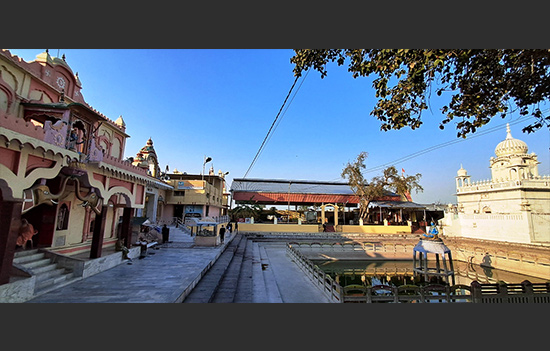 Sthaneshwar Mahadev and Gurdwara Nauvi Patshahi. Courtesy author.
Sthaneshwar Mahadev and Gurdwara Nauvi Patshahi. Courtesy author.
The garba griha’s odd shape for a temple, but then a board at the site started to help unravel many things. Kurukshetra was freed from Mughal occupation by the Marathas, which also meant that many temples
were freed.
Aurangzeb had
reintroduced the jizya and a tax on bathing in the Brahma Sarovar, both of
which eventually got abolished by the Marathas. Vikas ji later highlighted the
role played by Sadashiv Rao Bhau led Maratha forces in the entire process,
which makes one realise the significance of the Battle of Panipat being much
wider at the time. Mughalpura was a Muslim locality (Muslim colonialists did
that at various tirthas) that was deliberately built around the Brahma sarovar, and it was the Marathas who first freed it after centuries. It is pertinent to note that Abdali despite winning never reintroduced the jizya – such was the Maratha forces’ impact at the time. Eventually it became British territory. 8
It is therefore
speculated by many that the original temple was also destroyed and converted
into a mosque first during the invasions of Mahmud of Ghazni and later by many
other Islamic rulers including Aurangzeb. Quoting the level of destruction as
stated by Pande and Dorje (2016): 9
Thanesar
became victim of iconoclastic fury of Aurangzeb. He destroyed the sacred temples
at Kurukshetra and built a castle on the island in the Brahmsar tank called
Mughalpura from where soldiers could fire upon the pilgrims who came to bathe
there. The remains of a castle with pillars on four sides are still visible.
According to local tradition, the castle was demolished later by the Marathas,
who also removed the pilgrim tax which required the Hindu pilgrims to pay a
rupee for a small pot of water of the holy tank and five rupees for a dip in
it.
 Sthaneshwar Mahadev’s Garba griha. Courtesy author.
Sthaneshwar Mahadev’s Garba griha. Courtesy author.
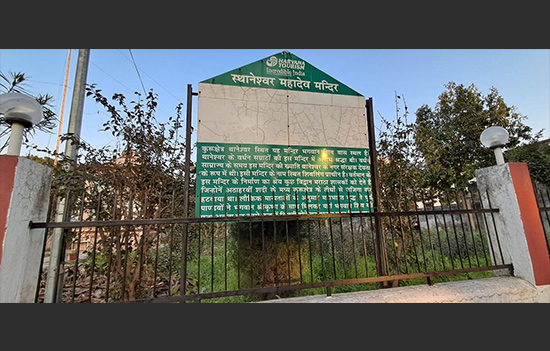 Signboard highlighting role of Marathas in freeing
Sthaneshwar. Courtesy author.
Signboard highlighting role of Marathas in freeing
Sthaneshwar. Courtesy author.
What was also fascinating was to see the Bhadrakali or Devikoop temple. This place, where it is believed that Sati’s right ankle fell, is associated with the Mahabharata. Pandavas with Sri Krishna offered worship here praying for their victory, and donated the horses of their chariots.
To this day, it is an age-old tradition of offering horses made of silver, mud etc, depending upon one’s means, once the desire have been met. What was fascinating for me from an amateur indologist’s lens, it felt like the continuation of the Ashvamedha yajna practice from the ancient times, which finds reference even in the Mahabharata. The reference to Ashvamedha comes
repeatedly across the 48 kos kshetra – bathing in the Brahma sarovar during an eclipse gives you the same merits as the Ashvamedha; so is the case with the Saraswati sarovar in Pehowa, which falls well within the region. Of course, the repeated references to Ashvamedha yajna, a Rg Vedic ritual, in Kurukshetra are not surprising. Writing on the Kurus Vedic janapada, Sudama Misra (1974) had written the following: 10
The
Rgveda mentions Kurusravana i.e. the glory of the Kurus as a prince with the
epithet Trasadasyavai, i.e. the desendent of Trasadasyu. But Trasadasyu is well
known as a Puru king. In the Rgveda again the Purus and the Bharatas are spoken
of as kindling fire on the Drsadvati, the Apaya and the Sarasvati. The Atharvaveda
mentions Pariksit as a king of the Kurus, and praises him. King Janamejaya, son
of Pariksit has been recorded to be a great performer of horse-sacrifice. In
the later Vedic literature the Kuru-Panchalas find joint mention and are
recorded to inhabit the central region.
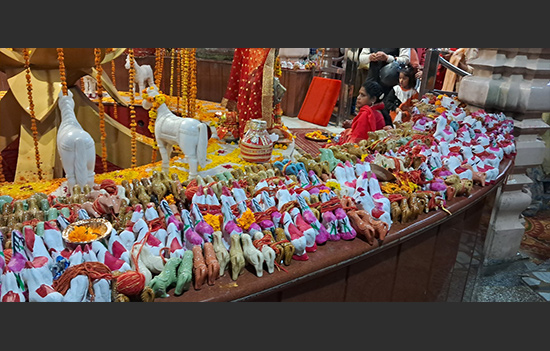 Bhadrakali Temple.
Bhadrakali Temple.
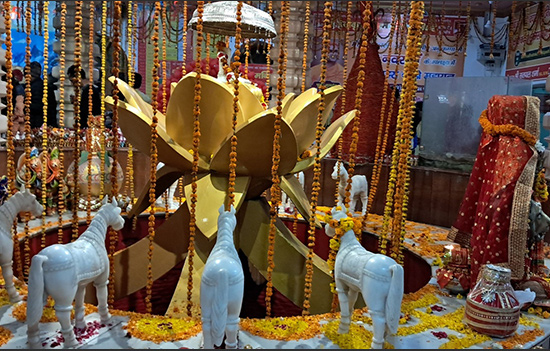 Bhadrakali Mandir.
Bhadrakali Mandir.
Kurukshetra
University used to be a hub of learning and scholarship, and its history and
oriental studies departments were landmarks unto their own years ago. While
much has changed, the presence of the Dharohar
Museum within the campus was a refreshing surprise.
Among many things that captured the essence of rural Haryana’s life, what kept bringing me back was the mural representation of Saanjhi Mata on the wall. And again, my mind was transported to the amazement of how Vedic
culture continues to survive and even thrive to an extent without common
awareness in the lands of Haryana.
Sandhya is
recognised in the Vedas as the wife of Surya, and also goes by the name of
Sanjna and Saranya. The tradition of worshipping Sanjhi mata during the
Sharadiya Navaratri in Haryana and parts of Punjab and western Uttar Pradesh is
very reminiscent of doing the worship of Mangala Gauri as well, indicative
perhaps of the transmission of traditions and their fusion over millennia.
 Sanjhi Mata mural at the Dharohar Museum. Courtesy
author
Sanjhi Mata mural at the Dharohar Museum. Courtesy
author
As I bid farewell to Kurukshetra, I couldn't help but feel a deep sense of gratitude for the experience. Kurukshetra is so much more, and a day and a half is frankly no time to explore its multiple facets and layers. What I hope to understand in subsequent visits is the manner in which Kurukshetra today remains a hidden tirtha and historical gem.
It is indeed, as
I think now, a Kashi they never told you about.
References
1 Heyzine.com
2 Monuments and Sites in Haryana, Archaeological
Survey of India, pp 34-35
3 Pande, B.M., and Dorje, C., Thanesar & Its Vicinity, 2016 First
Edition, Published by Archaeological Survey of India
4 Sachau,
E.W.,Ed., Alberuni’s India, An Account of the Religion, Philosophy, Literature, Geopgraphy, Chronology, Astronomy, Customs, Laws and Astrology of India about 1030AD, Kegan Paul, Trench, Trubner & Co, London, 1914
5 Blochmann, H.
(1873), Ain-i-Akbari of Abū al-Faz̤l ibn Mubārak, 1551-1602, Asiatic Society
of Bengal
6 Tribune
7 Nath, A. (2014).
EXCAVATIONS AT RAKHIGARHI [1997-98 to 1999-2000]. Archaeological Survey of
India
8 District Gazetteer of Kurukshetra, 2009
9 Ibid 3
10 Misra, S. (1973). Janapada State in Ancient India.
Bharatiya Vidya Prakashana, Varanasi, India.